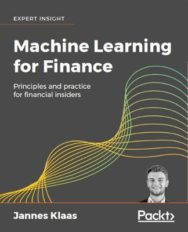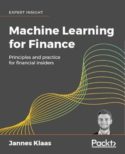
ABOUT THIS BOOK
PUBLISHER: Packt Publishing Limited
FORMAT: Electronic book text
ISBN: 9781789134698
RRP: £35.98
PAGES: 300
PUBLICATION DATE:
August 31, 2018
BUY THIS BOOK
As an Amazon Associate and Bookshop.org affiliate we earn from qualifying purchases.
Machine Learning for Finance: Data algorithms for the markets and deep learning from the ground up for financial experts and economics
Jannes Klaas
Introducting the study of machine learning and deep learning algorithms for financial expertsAbout This Book* A deep learning from scratch approach for economics and financial analysis* Reinforcement Learning for the rest of us* Does not shy away from traditional financial analysis topics like time series et al.Who This Book Is ForReaders should be comfortable with either C++ or Python. The author relies on mathematical intuition and a lot of code, so basic linear algebra is advantageous, but not necessary. Basic calculus helps with mathematical intuition, but reading the relevant articles on Wikipedia might suffice. No background in machine learning, deep learning or reinforcement learning is assumed.What You Will Learn* You will learn how to understand and use modern machine learning to financial data* You will understand the basics and some of the more advanced neural network and deep learning algorithms* You will be able to use general adversarial networks profitably* There is the very useful skill of neural network debugging, which is vital if you would like to get deep learning algorithms to work* You will be able to jump into reinforcement learning algorithmsIn DetailFinance experts and economists tend to be good mathematicians, but this qualification does not grant automatic understanding of machine learning or deep learning expertise. Machine Learning, deep learning and the new kid on the block, reinforcement learning all require new paradigms.Neural networks are fundamental to modern machine learning and of course deep learning, which Jannes Klaas is teaching from scratch. Then the book continues with a short case study on fully structured data, to then jump into visual data analysis with deep learning algorithms. The third chapter talks about an oldie-but-goodie, the analysis of time series data, which is common in the financial markets and other fields. But what happens when data are not well-structured enough to be saved to a relational database? This is where modern natural language processing comes in, which analyzes long strings, or sequences of text data. Generative Adversarial Networks (GANs) come in many varieties and flavors, but are applied to financial data and of course data retrieval, which is the use case Jannes Klaas is talking about in the next chapter.The final chapters of the book deal with reinforcement learning, which are suitable for rapidly changing data environments, for example, the financial markets. The book closes with a much needed chapter on debugging neural networks, a problem that anyone who has written neural network code from scratch in painfully familiar with and a chapter on data bias, which is vital to financial and economic data analysis.











